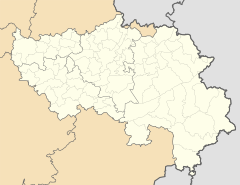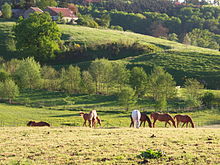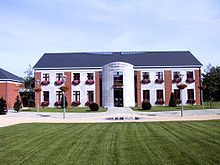Plombières
| Plombières | ||
|---|---|---|

|

|
|
|
|
||
| State : |
|
|
| Region : | Wallonia | |
| Province : | Liege | |
| District : | Verviers | |
| Coordinates : | 50 ° 44 ′ N , 5 ° 58 ′ E | |
| Area : | 53.18 km² | |
| Residents: | 10,459 (Jan 1, 2019) | |
| Population density: | 197 inhabitants per km² | |
| Post Code: | 4850 (Montzen, Moresnet) 4851 (Gemmenich, Sippenaeken) 4852 (Homburg) |
|
| Prefix: | 087 | |
| Mayor: | Marie Stassen (OCP) | |
Local government address : |
Administration communale Place du 3ème millenaire, 1 4850 Plombières |
|
| Website: | www.plombieres.be | |
Plombières (officially Bleyberg until 1919 , so still often in German-language media today, occasionally also Bleiberg , Dutch Blieberg ) is a political municipality in Belgium . The municipality is part of the triangle between the Kingdom of Belgium, the Federal Republic of Germany and the Kingdom of the Netherlands . It has 10,459 inhabitants (as of January 1, 2019) and belongs to the Walloon Region , the Province of Liège and the District of Verviers . It also belongs to the Euregio Meuse-Rhine .
geography
Geographical location
Part of the municipal boundaries is identical to the state border. The municipality is located about 12 km west of Aachen (D), 17 km north of Eupen (B), about 40 km east of Lüttich / Liège (B), 20 km north of Verviers (B) and 33 km southeast of Maastricht (NL ) away.
The neighboring communities / cities are in Belgium : Kelmis , Lontzen , Aubel , Welkenraedt , Teuven / Voeren , as well as in the Netherlands : Vaals and Gulpen-Wittem and in Germany Aachen .
landscape
The municipality has a rural character, but it is characterized by its close proximity to the three major cities of Liège (B), Aachen (D) and Maastricht (NL), the district capital Verviers (B) and Eupen (B), the Capital of the German-speaking Community of Belgium.
A popular regional excursion destination is the border triangle BD-NL on the Vaalserberg with excursion restaurants, the Tour Baudouin / Balduinturm observation tower - belonging to Gemmenich, approx. 50 m on the Belgian side - on the Dutch side with the largest labyrinth in Europe and just 30 m from the Drielandenpunt away, the highest point of the European Netherlands , belonging to Vaals , as well as many hiking opportunities in the Aachen forest in and through all three states. The Göhl flows through the village in a river valley and later flows into the Meuse in the Netherlands . The course of the river was permanently relocated for the earlier lead mining in the town. For this a tunnel was blasted through a rock; today the Göhl flows through the same over a small weir and an artificial waterfall.
structure
Plombières consists of nine districts:
- Plombières (Bleiberg / Bleyberg)
- Moresnet or Moresnet-Village ( Village , French for "village") (incorporated in 1975)
- Moresnet-Chapelle (part of the municipality of Moresnet), also known as Eikschen (a gen Eikske) .
- Hombourg (Homburg) (incorporated in 1977)
- Gemmenich (incorporated in 1977)
- Völkerich (part of the municipality of Gemmenich)
- Montzen (incorporated in 1977)
- Montzen-Gare ( Gare French "train station") (part of the municipality of Montzen)
- Sippenaeken (Sippenaachen) (incorporated in 1977)
The postcodes of Plombières are: 4850, 4851 and 4852.
population

The municipal boundaries of Plombières (see also the French Community of Belgium ) border within Belgium on the language and regional borders of the German-speaking Community and the Flemish Community of Belgium.
Plombières belongs to the so-called Low German communities with dialects of the Platdiets . Many of the residents of Plombières are multilingual and speak two to three languages. The natives speak partly a variant of Ripuarian and Standard German as their mother tongue , but also a Limburg dialect of Lower Franconian (or Rhine-Maasland ) that is colored from Lower Rhine to Dutch . The Gemmenicher Platt represents a mixed form . In addition, a Walloon dialect and French are cultivated at the same time .
High German was the school and church language until 1918 and was then replaced by French after the German occupation in World War I. At the request of the place, the German-sounding place name Bleyberg was changed to the French-sounding Plombières by royal decision in 1919. Since the vote on the linguistic assignment in Belgium in 1963, Plombières has officially belonged to the French-speaking area. In doing so, however, the law left open the possibility of later setting up facilities for administrative matters for Dutch and / or German speakers ("dormant" facilities). To date, no official use has been made of these facilities.
From the perspective of linguistic research, Plombières is a very interesting area.
In earlier times, the inhabitants of Bleyberg lived from mining . The first mentions of lead mining come from the 14th century. On June 23, 1825 the brothers John and James Cockerill received the concession for the Bleyberg mine. After the death of the brothers, their estate administrator Barthold Suermondt founded a new company under the name Société du Bleybergen Belgique , which was renamed Compagnie des Mines et Fonderies du Bleyberg ("Society of Mines and Foundries Bleyberg") on July 8, 1846 and in the same year also set up the lead smelter Münsterbusch near Stolberg on the German side . The last colliery in Plombières was closed in 1975 and the community has since suffered from high unemployment and increased emigration, especially of young people.
history
See also: Neutral-Moresnet (1815-1919)
As a border municipality, Plombières can look back on an eventful history. It is located in a low mountain range in the foothills of the Ardennes and the Eifel .
Plombières holds a political record throughout Belgium: On December 4, 2006, Thierry Wimmer was elected mayor of Plombières. At the age of 22, he was the youngest mayor of Belgium at the time of his election.
Culture and sights
The pilgrimage site Moresnet-Chapelle or Eikchen , also called a gen Ekske ('on the little oak'), in the Moresnet-Chapelle district has been a pilgrimage site with its miraculous image , which originally stood on an oak, the pilgrimage church and the way of the cross of regional importance, laid out in a park-like manner by the Franciscans between 1901 and 1903 The Calvary (Way of the Cross) with 14 station pictures by Wilhelm Albermann was looked after by the Franciscans of the Cologne Franciscan Province until December 31, 2005 . The religious men came to Moresnet 1875, when the Prussian State in the culture war , the religious orders banned. The monastery was converted into a Catholic meeting place.
In Moresnet-Village spans the viaduct of moresnet , one of the longest European Railway - viaducts , the valley of Göhl, with a length of 1120 m and a height of up to 58 m. It was built in 1916 when the place was occupied by the troops of the Imperial German Empire; from 2002 to 2004 the viaduct was extensively restored.
Alensberg Castle
Alensberg Castle was located on the outskirts of the village, in the immediate vicinity of the Göhl valley viaduct and the former lead mine . It was sold in 1823 by Arnold Timothée de Lasaulx to James Cockerill , who later bequeathed it to his daughter Caroline (1819–1867) and her husband Karl Suermondt (1822–1902), a brother of Barthold. After Karl's death, the property was first transferred to his son Armand Suermondt (1849–1921), who extensively restored the castle. In 1921, his brother Arthur Suermondt (1845–1922) received it, but he died only a year later. His family then put the property up for sale. In September 1944, when the nearby viaduct was blown up, the castle was so badly damaged that the owners demolished it except for the medieval five-story residential tower and the farmhouse belonging to it. The residential tower and the surrounding walls were repaired again from 2015.
photos
Web links
- Official website of the municipality of Plombières / Bleyberg (French)
- Dictionary and grammar of the regional dialect: Diksjonäär van et Jömelejer Plat - the dialect (optionally in German, French or Dutch)
- Official website of the Tourist Office of Hombourg
- Official website of the Three Borders Tourist Association (trilingual)
Individual evidence
- ↑ Examples: Kelmis drivers without a license cause a traffic accident in Bleyberg . July 1, 2017; Michaela Brück: Community of Bleyberg: New village house in Sippenaeken. BRF, June 23, 2015.
- ↑ Jens M. Warnsloh: Via Gulia - Göhltalroute: from Lichtenbusch to the Maas . Meyer & Meyer Verlag, Aachen 2012. p. 43.
- ^ Bleyberg Mining Company. P. 36
- ↑ J. Langohr: The Franciscan Monks in Moresnet Chapel. Father Johannes Ruiter, founder of the Way of the Cross in Moresnet Chapel . Syndicat d'initiative des trois frontières
- ^ Church, chapel and Calvaire of Moresnet-Chapelle
- ^ Notes on Karl and Caroline Suermondt
- ↑ Schloss Alensberg on trois-frontieres.be










